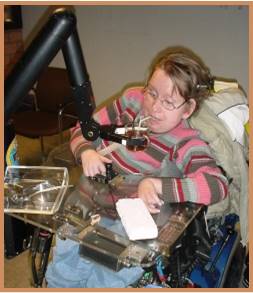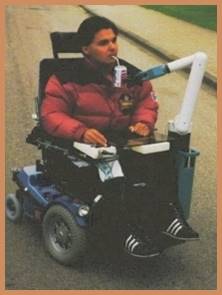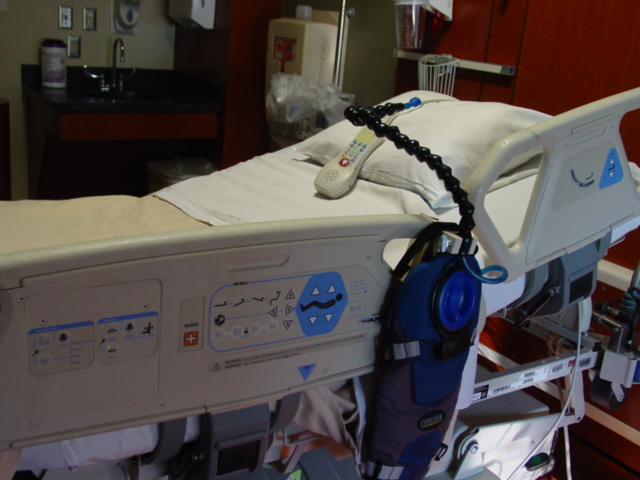September 2020 Independent Eating and Drinking Newsletter
| Independent Eating and Drinking are Wonderful |
 |
| September Newsletter Topics: |
|
| Subscribe to Newsletters |
Inventing Assistive Feeding Equipment
Twenty four years ago a “Survey of Assistive Feeders” was compiled. The intent of the survey was to fully understand the number of devices that were available internationally, that assisted people who could not eat independently, to feed themselves, and to understand how the equipment worked. The survey identified 14 different pieces of equipment. Some were manually operated, others were powered, and others were in the research phase of development. Several of the device designs were inspired by the needs of friends or family members who could not feed themselves. However, none of the devices were generally accepted by the population that they were designed for. Both individuals who might use the equipment and therapists who provides services to them described them as being too expensive, difficult to use, unreliable, inconvenient, difficult to transport, unattractive, and too time consuming to set up.
At the time the survey was compiled only one of the devices had been clinically evaluated. The Winsford Feeder, that was invented by Bill Morewood, was evaluated by 16 patients who had C5, and above, spinal cord injuries (SCI). Evaluations were conducted at Veteran’s Administration facilities in Miami, Palo Alto, Richmond, Long Beach, Castle Point and Wood. The results of the study found that only participants who had good trunk control were able to use the device and that they found it energy consuming to operate, and slower to use than being fed by someone. Also, they objected to the lack of volume control of the food that the device picked up for each spoonful. Only one study participant showed interest in using the device extendedly.
A decade later another study was conducted by Hermann, et al1, comparing 3 different feeding devices: The Winsford Feeder; the Beeson Feeder; and the Handy 1. The study concluded that participants preferred to use a feeding device than be fed by another person. By the time the study was published the Beeson and the Handy 1 had both been discontinued and were no longer commercially available.
By the time the 21st century arrived more interest was being shown in using computer and robotic technology to develop a range of equipment to help people who had disabilities. When robots first began to be developed, the hope was that they would quickly be developed to allow people to be able to feed themselves. It was hoped that they would mimic the human arm and hand in how they facilitated independent eating. Several robotic arms were developed but they were bulky and lacked the ability to handle a range of different food textures. They were, however, able to pick up a cup with a straw in it and hold it in the correct position for the user to drink.
 |
 |
| Robotic Arm Example | Robotic Arm on Wheelchair |
Powered feeding devices did not become very popular with people who could not eat independently. Very little research was conducted into the pros and cons of existing equipment or the characteristics of people who need to use a powered feeding device. Also, little research was conducted to identify why so many people were unable to use the existing equipment to eat. However, The Arc of the United States changed all of that by conducting significant research into equipment that existed and how it could and couldn’t meet the needs of the population that The Arc represents. They brought together a team of clinical experts along with engineers and consumers and their families and care providers. Existing equipment was reviewed and, in some cases, evaluated by potential users. What was found was that although some equipment could be used by a few consumers, none of the equipment that existed met the needs of the majority of those who needed it. One of the most fundamental problems identified was access to the equipment. People who used powered wheelchairs, and/or had skeletal anomalies, etc., were not able to reach the equipment because it was placed on the table for use and the user was unable to get close enough to it to eat from it.
Based on the findings of their research, The Arc developed a prototype feeding device that met all of the requirements identified by their advisory panel. After many iterations and extensive clinical evaluation, this prototype evolved into what is now known as the Mealtime Partner Dining System.
In March of 2020 researchers from the University of Washington in Seattle Washington2 reported on research that they have been conducting that looked at how much autonomy people who are dependent eaters would like when using a robot to feed themselves. Because the intricacies of handling food were beyond the scope of the research, some functions of the robot arm were controlled by the user while the tasks were completing automatically after initiation. Additionally, part of the research included errors that occurred when the robot arm was operating. Errors were actually simulated to understand how users responded to problems that might occur. Though this research did not result in the production of a robot arm that could facilitate independent eating, it did find, as the Comparison of Feeding Devices, described earlier, found, that people would prefer to feed themselves than being fed.
However, despite the majority of people who are fed wanting to feed themselves using a feeding device or robot arm, there is a high abandonment of assistive technology once it loses its novelty. Therefore, it is important that prior to acquiring equipment, individuals are thoroughly evaluated to be sure that the equipment a good fit for the user and the caregiver, and that it is not going to be abandoned once the novelty wears off. The greatest likelihood of lifetime use is if the technology is provided when the user is young. It simply becomes part of their normal routine. Adults who acquire a disability are comparable to children and young adults in their continued use of assistive technology. Older people who have had a lifetime disability and have had a long history of being fed might find that the effort of being independent isn’t as good as they thought it would be.
1. https://www.archives-pmr.org/article/S0003-9993(99)90022-9/pdf
2. Exploring Preferences of Users with Mobility Impairments in Robot-assisted Feeding. Tapomayukh Bhattacharjee, Ethan K Gordon, Rosario Scalise, Maria Eugenia Cabrera, Anta Caspi, Maya Cakmak, Siddhartha S Srinivasa.
|
The Hospital Bed Drinking System |
|
Meeting
hydration needs for hospital patients who are unable to use
their hands or arms to drink. The Hospital Bed Hydration System from Mealtime Partners is suitable for patients who have difficulty picking up or holding a cup while lying in bed in the hospital. Adequate hydration is essential for the best medical outcomes for all patients. But, when a patient is unable to take a drink independently, it becomes the responsibility of hospital staff to ensure that adequate water is consumed. However, this increases the workload for staff and it requires the patient to request assistance whenever they are thirsty. |
 |
| The Mealtime Partners Hospital Bed Hydration System |
Making liquid constantly available allows the user to drink whenever they want. This lowers the risk of dehydration and improves the quality of life for those who have one of these systems. Click on the following link for more information about the Hospital Bed Hydration System. For more information about all of the Mealtime Partners drinking systems and information about choosing the most appropriate drinking system, click here. |
Can We Try This Drinking System?
Because we cannot allow trials of our drinking systems we try very hard to help people select the best system for the individual who will use it. Some of the things that need to be considered are:
Can the person drink through a straw? If the answer is NO, none of our hands-free drinking systems are appropriate.
If the answer is YES, the following table can assist you in determining which drinking systems are suitable based on the characteristics of the user. A YES in the user profile row of the Table below, indicates that the drinking system listed above is appropriate.
|
|
||||
|
Has
normal suction |
YES |
YES |
YES |
YES |
|
Has
weaker than normal suction |
|
YES |
|
|
|
Does not
have enough hand movement to lift a straw to their mouth |
YES |
YES |
YES |
|
|
Has poor
head and chin control |
|
YES |
|
|
|
Liquid
must be available for many hours without replenishment
(capacity) |
YES |
(Capacity varies, usually 12 to 24 oz.) |
YES (50 or 70
oz.) |
YES |
|
Spends
the majority of time in bed |
YES |
|
YES |
|
|
Wants to
drink a variety of liquids including coffee, soda, etc. |
|
YES |
|
|
The drinking systems with long drink tubes require more suction than those with short tube length (like normal straws). They can access fluids from a greater distance where larger fluid containers (usually, bladders) can be placed, often out of sight of the user. Larger quantities of liquid will require less attention by attendants. However, due to clean-ability, only water is recommended for use with these drinking systems. The use of "sugary" drinks will require frequent cleaning.
The easiest drinking system to clean is the Front Mounted Drinking System, which is a drink holder system so that the user can drink from their own cans, cups, or other containers. These containers are usually either dishwasher safe, or disposable. Straws with these containers are inexpensive and disposable, eliminating the requirement for cleaning.
For more detailed information about the drinking systems referenced in the table, click on the name of the drinking system at the top of each column. For additional information about how to select a drinking system, please visit our website and select “Drinking”, or call us at 800-996-8607.
|
Did you know? Did you know that it is especially important to get your flu shot during the COVID-19 pandemic? Each year at the beginning of fall we are advised to get a flu shot. Some years the flu season can be worse than others, but if you have had a flu shot the severity of the flu, should you catch it, should be lighter. In 2020 we are facing both COVID-19 and flu. Recommendations from the Centers for Disease Control and Prevention (CDC) are that everyone from the age of 6 months upward receives a flu shot by the end of October. Having the shot too early might impact how well the immunization lasts. Infants and individuals who are sick or have a compromised immune system, and the people who are around them, should talk to their doctor about when to receive their vaccination but it is very important to get a shot. One bright spot in this otherwise worrying time is that reports from the southern hemisphere (that has just experienced winter) is that the flu season has been mild this year. This could be because people have followed the guidelines for controlling the corona virus: wear a mask; keep 6 feet away from other people, and wash your hands often, and these precautions have protected them from flu as well as COVID-19. Throughout the 2020-2021 flu season, take every precaution you can to remain well and avoid catching anything. For more information refer to the CDC website at https://www.cdc.gov/flu/index.htm. |
Click here to subscribe to the Mealtime Partners Newsletters
Please send comments and suggestions to newsletters@mealtimepartners.com
Copyright © Mealtime Partners, Inc. 2020
All rights reserved.
Mealtime Partners Website Navigation: